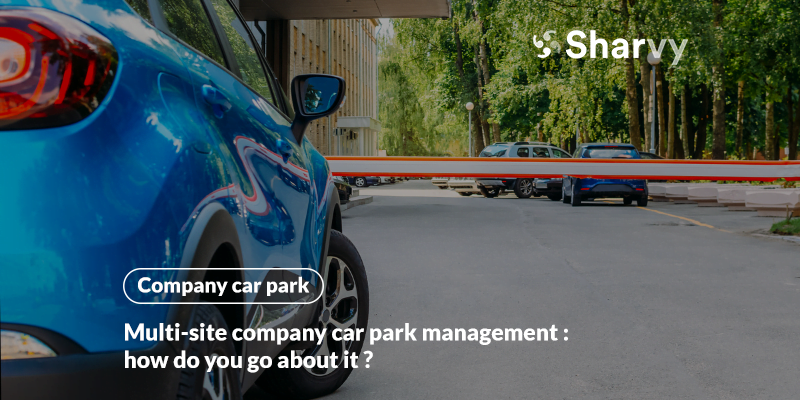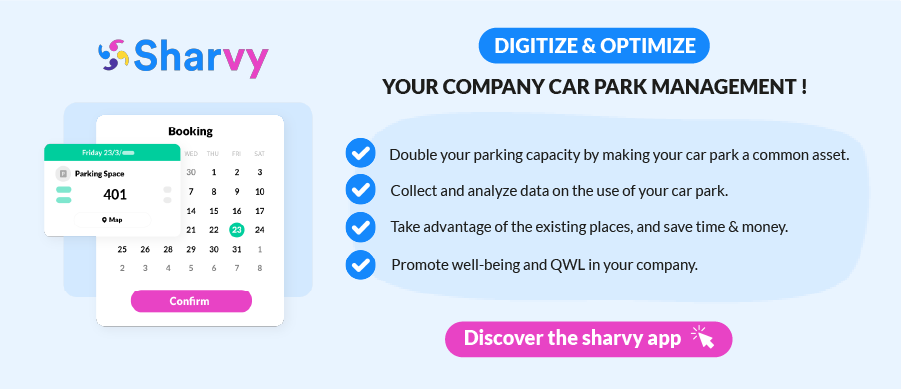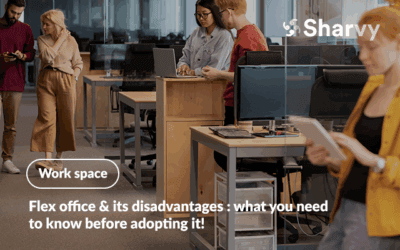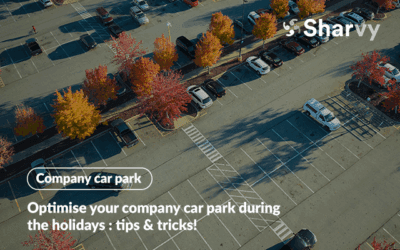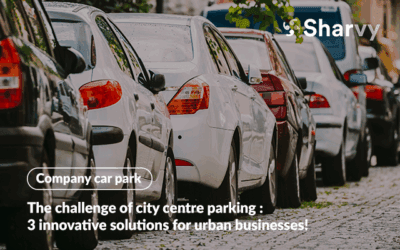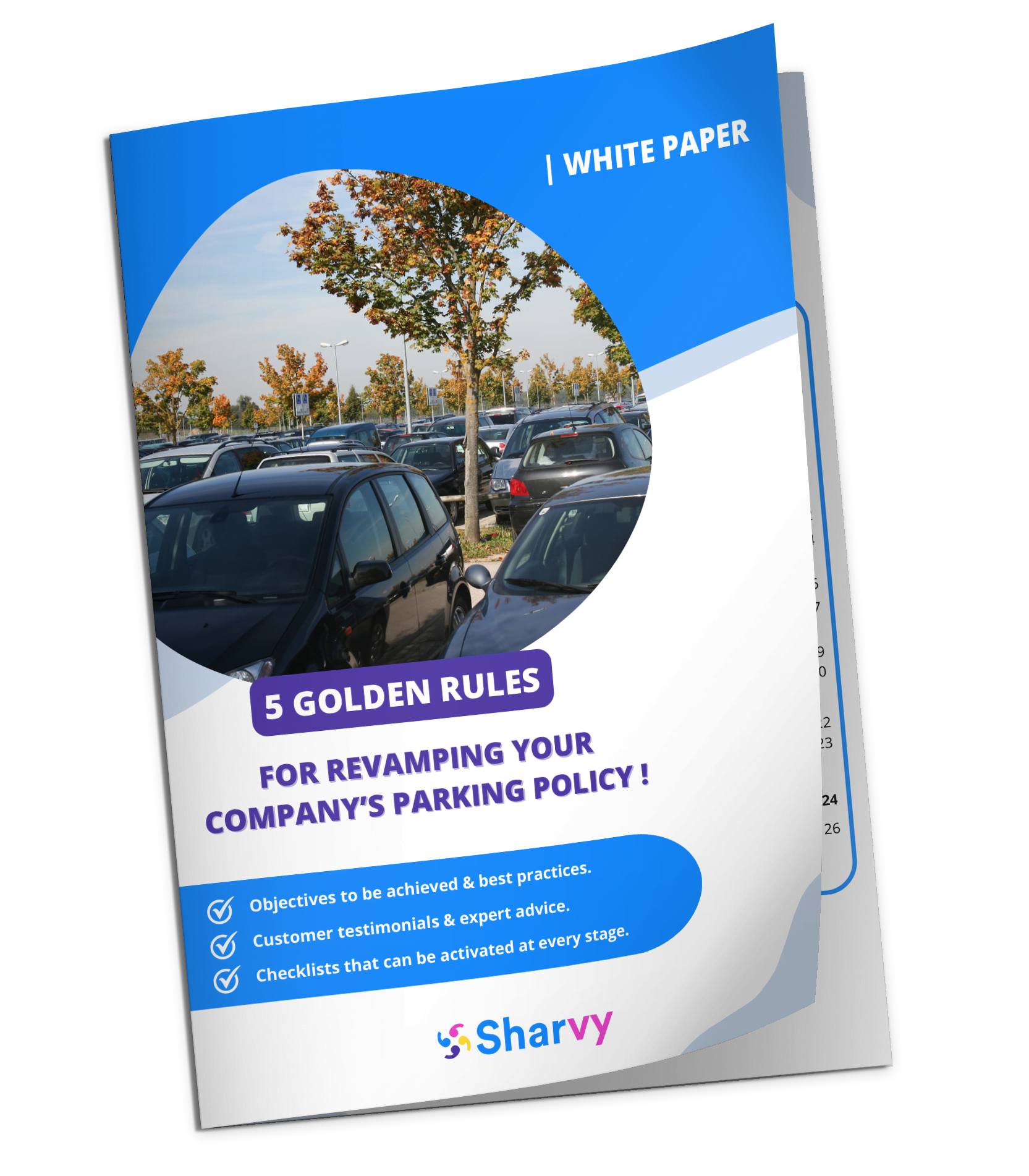In recent years, the implicit rule that an employee must be present on the company premises to be active and effective is increasingly being overturned.
As a result, teleworking is gaining ground, and many companies are now making hybrid working the norm.
However, this new work organization raises the thorny issue of employee mobility, which is increasing. Employees are now constantly moving from one site to another. While some make these trips for a day, others are forced by their duties to be at one site two or three days a week and at another location the rest of the time.
This increased flexibility reveals several organizational challenges, particularly managing multi-site car parks. For a long time, considered a real headache by companies, but this management can now be significantly simplified. Focus on the solutions to adopt in this article!
Multi-company car park management : what are the problems faced by companies?
Today, the issue of smooth and safe access to the car park is a prerequisite for a positive parking experience for users.
However, with frequent requests for access to the car park (whether for permanent employees, one-offs, or possibly temporary visitors), it can be difficult for security and/or reception staff to manage everyone’s entry and exit. As a result, access flow is reduced, and security needs to improve.
At the same time, the multiplication of a company’s sites and car parks makes it more difficult for users to obtain visibility on the availability of parking spaces. Consequently, in the event of unavailability, they need help to anticipate and find alternative means of transport.
As a result, multimodality is not encouraged, and users waste a considerable amount of time looking for a parking space close to their place of work. This is especially true if they have yet to anticipate this, which can jeopardize their schedule.
Added to this is that the costs of implementing and managing multi-location are substantial and increasingly burdensome. This is true for both companies and employees. Employees find this management frustrating and unsatisfactory.
As a result, and given these inconveniences, it is understandable that companies consider multi-site parking management to be the dark point of their parking policy.
7 tips for facilitating your multi-company car park management !
If until now the availability of parking in company car parks was not a problem (hence the lack of management in many structures), this is no longer a reality today.
To improve well-being and quality of life at work, it is essential to deploy a policy that is : harmonized across all sites, reliable, flexible, and, above all, easy to implement. But how do you go about it? Here are seven tips to apply rigorously to excel in the management of your multi-site car parks.
1. Segment and list the needs of your employees !
An obvious first step to take before embarking on this optimization process is to carry out an audit of the current situation.
To do this, ask yourself several questions : has your company (explicitly) defined a parking policy for all sites? Is it known to all employees (permanent and temporary)? Does it consider the particularities and/or constraints of each individual? Is it fair? Conversely, are directors and managers given preference (allocation of a parking space, permanent access to the car park)? And so on.
To answer these questions, you need to know the habits of your employees and be aware of the needs, adaptations, and requirements of each one.
Some of your employees will be ready to accept a modal shift from car to bicycle. This is in exchange for a permanent parking space for the bike. On the other hand, for other employees, car use is unavoidable because of the distance between home and work, a house with poor public transport links, children to be taken to and from work every day, medical constraints, etc. However, they will agree, for example, to organize a carpool.
In the end, keep in mind that communication and employee feedback on this subject can be the key to good management of your parking policy!
By asking questions about this segmentation and about the habits of each individual, you will be able to define a viable, fair (and impartial) policy more easily! As a result, frustrations will be reduced, and the Quality of Life and Working Conditions (QWLC) will be improved.
✔ Our bonus suggestion :
To target the actions that (really) meet the needs and expectations of your employees and thus guide your optimization strategy in the right direction, it is a good idea to survey your employees.
If you have any doubts about constructing your employee survey and including the “right” questions, our white paper (free to download) can help you.
2. Unify access management across your company’s sites
Many companies mistakenly believe they have no choice but to opt for a different access control solution for each building. However, the cost of implementation, maintenance, and management (both for the company and the employees) are restrictive!
It is now possible to unify the access management of all your company’s sites by opting for a centralized SaaS solution.
Today, this type of solution is compatible with many access control systems (RFID badges & cards, IoT modules, cameras, etc.). In addition to this advantage, these solutions make it possible to harmonize practices and facilitate the management of multi-site car parks.
✔ Our bonus suggestion :
There is no doubt that choosing to unify access management across all your sites is one of the best solutions for facilitating the flow of people in and out of the car park. Furthermore, this dramatically simplifies the administration of access rights, whatever the type of user (permanent, occasional, temporary visitors, etc.).
However, more than the SaaS solution is needed. One person must be assigned to manage all the sites. This person takes on the role of a “super administrator” and will supervise this management. Not only do they have an overview of all the sites, but they also decide on the distribution of access rights and the way they are administered.
In this way, you have a unified and harmonized system for managing the access control of your multi-site car parks.
3. Provide better visibility of site parking availability
The major frustration of motorists when it comes to parking is the need for more visibility on the availability of parking spaces.
To overcome these frustrations and to make the parking experience more dynamic and better for users, it is wise to integrate New Information and Communication Technologies (NICT) into your car park.
These offer your employees dynamic and, above all, real-time monitoring of your multi-site car parks. Thus, they obtain (via a web and/or mobile application) visibility on the availability or unavailability of parking spaces in your car parks. They will better anticipate their daily needs and modes of transport.
For example, suppose a parking space is unavailable, rather than driving around in circles to find a parking space near the workplace. In that case, employees will prefer public transport, bicycles, or even NEVs (New Individual Electric Vehicles), such as electric scooters, hoverboards, etc.
As a result, they save time, favor soft mobility, and limit the air pollution caused by the search for parking.
✔ Our bonus suggestion :
Remember that parking and mobility will undoubtedly become more connected, fluid, and flexible in the future. So take the plunge now, and offer your employees the right tools and services, like the Sharvy app.
4. Simplify the reservation and release of spaces in all car parks!
It is essential to rethink uses to reconcile the obligation to free up space with a user’s parking needs.
All the more so as 88% of employees believe that it is the company’s role to take greater account of their mobility problems to promote their well-being and limit the environmental impact of their home-work journeys.
To achieve this, various digital solutions allow your employees to anticipate their presence at the company and foresee a need for parking in advance.
- If an employee has a seat and plans to be absent from the office, they will responsibly & independently release the seat and return it to the “common pot.”
- Conversely, if the employee requests a parking space, they will make a request (via a dedicated application) and obtain a space according to a specific algorithm.
These digital solutions allow you to excel in managing multi-site car parks and, above all, to give all or some of your employees access to different car parks.
For example, by integrating a parking system with reserved spaces for employees rotating between sites, a company can optimize the use of its parking facilities. Moreover, by using a mobile application, you can see available spaces in real time, reserve your parking spot, or release an unused space. Such management not only simplifies the parking process but also enhances satisfaction by offering more control and flexibility in your commutes between the company’s different sites.
At the same time, you promote the rotation of parking space use, which makes the holder less reluctant to use public transport and/or favor soft mobility. And this without losing the use of the parking space, which encourages multimodality.
✔ Our bonus suggestion :
If you want to share parking spaces between your employees on different sites of your company, Sharvy is the solution.
Thanks to the Sharvy application, the possibilities for managing your multi-site car parks are endless! You can imagine rules of good use, systems of prioritization or sharing of spaces between users, rules of equity, etc. But above all, you offer your employees the possibility of reserving and/or freeing a parking space.
The sharing of spaces and the collaboration of all agents generally make it possible to evaluate the potential for additional spaces available by at least 30%. This is the case, for example, of the Conseil Départemental des Yvelines (France), which uses Sharvy to manage its 420 parking spaces spread over two sites.
Florence DUHAMEL, the Car Fleet Manager at the project’s launch, emphasizes that “the solution is very flexible, functional, and easy to use. The users understand the interest and comply with the systematic reservation rule.
Curious to know more about it? Check out the dedicated case study.
5. Monitor the occupancy rate of your sites and adapt your parking policy
Keep in mind that for your parking policy to be sustainable, it must not remain static. Instead, it must continuously adapt to the mobility needs of its employees and the circumstances.
To do this, you need to extract various data daily and keep track of numerous statistics regarding the use of your car park. For example, by distinguishing :
- Theoretical occupancy of your car parks : the number of reservations and permanent accesses minus the number of vacancies.
- Actual occupancy : This can be observed thanks to a history of requests to open the gates of your car parks.
It is interesting to observe this occupation per day, per hour on a typical day, and also to make an average according to the days of the week. This can be done by distinguishing between the different types of spaces (e.g., with a charging point, PRM, car, two-wheeler, etc.).
At the same time, it is also a good idea to monitor the activity of your employees, distinguishing between those who have a named parking space, permanent and occasional employees, and visitors.
The aim of this regular monitoring is, above all, to be alerted, at the right time, to changes in needs. This will allow you to make the right decisions in time and adapt your strategy.
✔ Our bonus suggestion :
You may have wondered what the warning signs are. At what point does the parking policy need to be re-evaluated?
To help you, observe the ratio between the number of theoretical arrivals and the number of spaces. If the latter is high, this may indicate tension in the car park studied.
If this tension reflects reality, then corrective measures should be applied. For example, you can make bookings more fluid by adapting your teleworking policy. Another option is to remind people of good practices. For example, users may only show up if they have reserved parking spaces.
In this case, identify those users who do not vacate their space, and if this happens repeatedly, take proactive measures and/or adjust the access modes if they are not adapted to the actual usage.
6. Improve the parking experience by promoting equity!
A positive parking experience for users inevitably involves sharing and pooling parking spaces.
Remember that the company car park is, for many employees, the entry point to their work environment. Thus, you avoid various daily constraints by giving all or some of your employees access to the car park.
To achieve this, sharing and/or pool parking spaces are inevitable. In an age of individualism, this is a way of reversing the trend and restoring equity and solidarity within companies.
✔ Our bonus suggestion :
To restore fairness, the main thing is to end the traditional allocation criteria based on seniority and/or hierarchy. Different from before, it is essential that not only managers have access to the car park. From now on, all employees must be on an equal footing.
This notion of equity, which calls for impartiality, is essential. It now serves as a lever to create and maintain a healthy work environment, while retaining employees through good management of your company car park.
7. Empower your employees!
To make the management of your multi-site car parks easier and less of a headache, you need to make your employees more responsible.
The aim is to encourage their autonomy and to adopt a respectful attitude towards the community. But above all, to promote awareness of the importance of personal initiative. In the long run, this helps affirm the conditions for living together.
However, to give your employees responsibility in the long term, remember that you need a robust corporate culture! Your employees must recognize themselves in a common culture and be proud to contribute to the success of your company’s parking policy.
✔ Our bonus suggestion :
One of the first good practices we can give you is to make your employees understand what you expect and why it is essential (giving meaning promotes motivation and commitment).
For example, be transparent with your employees who have a parking space. Tell them their cooperation is essential to excel in your car park management and allow everyone to benefit equally.
Secondly, be clear with your objectives. Think “measurable” and set success indicators for your employees. Communicate these objectives. For example, one of the objectives of integrating a dedicated application like Sharvy is to allow 10% more employees to use the car park daily. Another goal might be to save at least 25% on the parking budget through the app, etc.
With direction (i.e., internal communication of targets), there is progress and more employee commitment.
In summary?
There are various ways to improve the management of your multi-site car parks. However, strictly following the above tips can tackle these issues head-on.
Your employees will be even more satisfied, as you will solve recurrent complaints about its management and offer them a positive parking experience. In addition, you will project an image of a company that cares about the well-being of its employees. This is achieved by developing an intelligent, fair, and proactive parking policy at your company’s multi-site car parks.
Have a question? Check out the FAQ!
What type of access control should be used to facilitate the multi-company car park management ?
Having a gate, a security barrier, and/or a retractable access control terminal is an essential first point. In addition to this installation, it is wise to favor two types of access control, namely :
A camera with number plate recognition : positioned at the entrance automatically activates the barrier’s opening only to vehicles previously registered and authorized to enter the car park on the day.
An IoT module linked to a dedicated application : connected to the automatic barrier and/or gate, the user’s smartphone becomes an actual remote control allowing the gate or security barrier to be opened on demand.
These two solutions facilitate and regulate the flow of people authorized to enter. In addition, the arrival of occasional employees and/or visitors does not complicate access management.
How long, on average, does it take to implement a single digital solution in a company's multi-site car parks ?
The deployment time of the solution varies according to the profile of the spaces to be created (technical specificities or not, installation of access control equipment, specific developments, etc.).
Generally speaking, a minimum of 3 to 4 weeks is required. For the person in charge of the project, this is often the average time needed to collect and list all the elements specific to the company and the different sites. For example, the number of named spaces, the total number of areas, the specific features of the parking spaces, the current access control system, the desired developments, etc.
Want to learn more? Check out our latest articles!
Flex office & its disadvantages : what you need to know before adopting it!
What is the flex office? How does it work? What are its drawbacks and how can you overcome them? Find the answers in this article!
Optimise your company car park during the holidays : tips & tricks!
How can you reinvent your company car park management during the holidays? What solutions and tips can you come up with? Focus!
The challenge of city centre parking : 3 innovative solutions for urban businesses!
Urban businesses : what solutions can be found to meet the challenge of city centre parking? Our advice and tips in this article!
Subscribe to our newsletter!
Resources
Contact us
+44 117 463 6990

